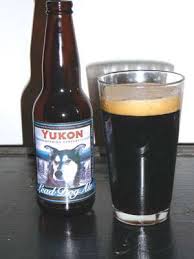 As regular readers will know I like to play around with different beer taste experiments to draw out insights into how beer is affected. For example, the recent bottle/can/keg test brought out surprising results, and, of course, the classic Sam Adams glass test was illuminating. Side-by-side tastings of beer made to the same style can also be fun.
As regular readers will know I like to play around with different beer taste experiments to draw out insights into how beer is affected. For example, the recent bottle/can/keg test brought out surprising results, and, of course, the classic Sam Adams glass test was illuminating. Side-by-side tastings of beer made to the same style can also be fun.
Recently Yukon Brewing (more specifically Yukon Dave on their behalf), offered up an opportunity I couldn’t refuse: a vertical test. They provided me two bottles of their Lead Dog Ale, which is their hearty winter warmer. The one bottle was virtually new, packaged in fall 2012. The other was bottled in June 2010, over 2 1/2 years old. (I should note the actually taste test occurred about 6 weeks back, so keep that in mind when evaluating the dates).
Now, over two years is likely pushing the outside boundaries of this 7% beer, but I was assured it was gently handled and stored so should still be in shape to provide a good comparator.
So, one evening I pulled the two bottles out of my cellar, where they were stored side-by-side. Poured them into identically shaped glasses, and alternated sips. No need for a blind test here, as the differences would be big enough to make identification a piece of cake.
What did I get? Well, the new bottle tasted as you would expect. It poured a dark cola brown with a thin, off-white head. Carbonation has always been moderate in this beer, and was again. There was an aroma of caramel, toffee, chocolate, some rounded maltiness, a hint of dark malt and subtle dark fruit. The flavour brings out chocolate, dark caramel, soft malt with accents of dark fruit. It has the rounded body I expect from Lead Dog, but finishing with a touch of dry roastiness.
The older bottle had the same look, even down to the head. The aroma shared caramel, toffee and light chocolate, but also had a noticeable raisin character. The rounded maltiness of the aroma had slipped away – the beer smelled thinner and drier. In the sip, I still picked up the rich malt, toffee and dark fruit character, although I also detected some burnt sugar for some reason. But what really comes out is a strong sherry note to the beer. It is not unpleasant and gives a bit alcoholic character. the finish is a bit sharper and a bit drier than the new one. The body doesn’t seem as full. In the linger is the tiniest bit of sourness, hiding in a corner, but present.
The difference is clear. The older is thinner, sharper and more alcohol-y. It loses the rounded complexity of the malt found in the young bottle. However the sherry note adds a nice dimension to the older version, giving it more of a sipping quality. I suspect I got this beer at the edge of the positive end of its life cycle. That faint sour I picked up complimented the sherry, but I if it continues to build it might overpower. I also wonder if in the coming year that sherry will develop into a more straightforward cardboard oxidation? Maybe not.The beer might have enough malt complexity and alcohol to stave off the worst of aging’s effects. If it was two percent or so higher in alcohol, I am almost certain it would nicely age for a few years. At 7% I think there is only so long it can go before it gives up the ghost. But at 2+ years it was still holding in there, which is pretty good.
My straight up preference would be the new bottle, but that is in part because that is what I expect from this beer (and, of course, what they intend to brewe). It is just interesting to not how it fared over time.
A vertical test with full fledge barley wine or Imperial Stout (or a lambic) might be a more fulsome endeavour, as they are beer designed to hang around for years. But this had its own attraction. A beer big enough that it can be aged for a moderate period of time, but not so big that drinking it young seems like a waste (as it can be with barley wines and their ilk).
Thanks again to Yukon Brewing, who currently are the undisputed champions of taste experiments over here at onbeer.

April 12, 2013 at 12:21 PM
Love hearing about the side by side tastings! It’s always a fun thing to do but I haven’t had the opportunity to try with different ages of the same beer. Thanks for the notes!
April 12, 2013 at 5:41 PM
We have a bit of a stock of older beers here at the brewery, not as large as it would be had we shown the foresight. The oldest Lead Dog we have is from 2000, and there are still four (very dusty) bottles of that in the six pack. The last time we opened one was at last summer’s staff party, and it was extremely tasty. More of the prune/raisin notes you mention, almost a bit of a port flavour, but overall it has stood up extremely well. We are just about to christen our new warehouse building, maybe it is time for a 13 year old Dog real soon!